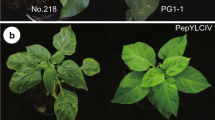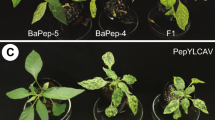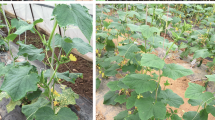Abstract
Pepper yellow leaf curl disease caused by begomoviruses has emerged as a major limitation to the cultivation of pepper (Capsicum spp.) production in a number of regions around the world. Although begomovirus resistance has been reported in several accessions, pepy-1 derived from BaPep-5 (C. annuum) is the only begomovirus resistance gene cloned to date. In this study, we evaluated the resistance of a C. chinense accession GR1 against pepper yellow leaf curl Indonesia virus (PepYLCIV), which is one of the predominant begomovirus species infecting pepper plants in Indonesia. Infection of PepYLCIV to susceptible Habanero (C. chinense) plants induced typical yellowing symptoms, whereas the GR1 plant showed symptoms with very low severity. Moreover, the accumulation of viral DNA was restricted in GR1 compared to Habanero. Phenotypic analyses of F1 and F2 populations obtained by crossing Habanero with GR1 inferred that the resistance is a dominant trait controlled by multiple genes. Linkage analysis in the F2 population using restriction site-associated DNA sequencing data detected two significant quantitative trait loci (QTLs), one on chromosome 4 and another on chromosome 11, which explained 31.6 and 19.7% of the phenotypic variation, respectively. Moreover, QTL-seq conducted using F3 population partially confirmed the result of F2 population, which detected QTLs on chromosome 3 and 11, respectively. The QTLs identified for PepYLCIV resistance in this research are novel since no other resistance causing QTLs have ever been reported in these genomic regions. GR1 is a highly valuable genetic resource for the breeding of begomovirus resistance in peppers.





Similar content being viewed by others
References
Adluri PK, Baldoldiya GM, Nath PD (2017) Screening of Bhut Jolokia (Capsicum chinense Jacq.) germplasm of North East India against chili leaf curl virus. Int J Pure Appl Biosci 5:1189–1196
Agrama HA, Scott JW (2006) Quantitative trait loci for Tomato yellow leaf curl virus and Tomato mottle virus resistance in tomato. J Am Soc Hortic Sci 131:267–272
Anbinder I, Reuveni M, Azari R, Paran I, Nahon S, Shlomo H, Chen L, Lapidot M, Levin I (2009) Molecular dissection of Tomato leaf curl virus resistance in tomato line TY172 derived from Solanum peruvianum. Theor Appl Genet 119:519–530
Barchenger DW, Yule S, Jeeatid N, Lin S, Wang Y, Lin T, Chan Y, Kenyon L (2019) A novel source of resistance to Pepper yellow leaf curl Thailand virus (PepYLCThV) (Begomovirus) in chile pepper. HortScience 54:2146–2149
Barrera-Pacheco A, Joaquín-Ramos A, Torres-Pacheco I, Gonzalez-Chavira M, Perez-Perez C, Guevara-Olvera L, Guevara-Gonzalez RG (2008) Analysis of transcriptional expression induced in Capsicum chinense BG-3821 under conditions of biotic and abiotic stress. Agrociencia 42:95–106
Bosland PW, Votava EJ (2000) Peppers: vegetable and spice capsicums. CABI Publishing, New York
Broman KW, Wu H, Sen Ś, Churchill GA (2003) R/qtl: QTL mapping in experimental crosses. Bioinformatics 19:889–890
Carrizo García C, Barfuss MH, Sehr EM, Barboza GE, Samuel R, Moscone EA, Ehrendorfer F (2016) Phylogenetic relationships, diversification and expansion of chili peppers (Capsicum, Solanaceae). Ann Bot 118:35–51
Devendran R, Kumar M, Ghosh D, Yogindran S, Karim MJ, Chakraborty S (2021) Capsicum-infecting begomoviruses as global pathogens: host-virus interplay, pathogenesis, and management. Trends Microbiol. doi: https://doi.org/10.1016/j.tim.2021.05.007
FAOSTAT (2019). http://www.fao.org/faostat/en/#data/. Accessed 16 Aug 2021
García-Neria MA, Rivera-Bustamante RF (2011) Characterization of geminivirus resistance in an accession of Capsicum chinense Jacq. Mol Plant Microbe Interact 24:172–182
Gilbertson RL, Batuman O, Webster CG, Adkins S (2015) Role of the insect supervectors Bemisia tabaci and Frankliniella occidentalis in the emergence and global spread of plant viruses. Annu Rev Virol 2:67–93
Guevara-Olvera L, Ruíz-Nito ML, Rangel-Cano RM, Torres-Pacheco I, Rivera-Bustamante RF, Muñoz-Sánchez CI, González-Chavira MM, Cruz-Hernandez A, Guevara-Gonzalez RG (2012) Expression of a germin-like protein gene (CchGLP) from a geminivirus-resistant pepper (Capsicum chinense Jacq.) enhances tolerance to geminivirus infection in transgenic tobacco. Physiol Mol Plant Pathol 78:45–50
Hutton SF, Scott JW (2014) Ty-6, a major begomovirus resistance gene located on chromosome 10. Rep Tomato Genet Coop 64:14–18
International committee on taxonomy of viruses (ICTV) (2020). https://talk.ictvonline.org/taxonomy/. Accessed 16 Aug 2021
Ji Y, Scott JW, Schuster DJ (2009) Toward fine mapping of the Tomato yellow leaf curl virus resistance gene Ty-2 on chromosome 11 of tomato. Hortscience 44:614–618
Ji Y, Scott JW, Schuster DJ, Maxwell DP (2009) Molecular mapping of Ty-4, a new tomato yellow leaf curl virus resistance locus on chromosome 3 of tomato. J Am Soc Hortic Sci 134:281–288
Kang BC, Yeam I, Jahn MM (2005) Genetics of plant virus resistance. Annu Rev Phytopathol. 43:581–621
Kenyon L, Kumar S, Tsai WS, Hughes Jd, ’A (2014a) Virus diseases of peppers (Capsicum spp.) and their control. In: G. Loebenstein and N. Katis (eds) Advances in virus research Vol 90 Academic Press pp 297–254
Kenyon L, Tsai WS, Shih SL, Lee LM (2014b) Emergence and diversity of begomoviruses infecting solanaceous crops in East and Southeast Asia. Virus Res 186:104–113
Kim S, Park J, Yeom SI et al (2017) New reference genome sequences of hot pepper reveal the massive evolution of plant disease-resistance genes by retroduplication. Genome Biol 18:210
Koeda S, Fujiwara I (2019) A simple DNA extraction method for begomovirus detection and genotyping of host plants. Trop Agr Dev 63:34–37
Koeda S, Kesumawati E, Tanaka Y, Hosokawa M, Doi M, Kitajima A (2016) Mixed infection of begomoviruses on pepper plants at Northern Sumatra, Indonesia. Trop Agric Dev 60:59–64
Koeda S, Homma K, Tanaka Y, Onizaki D, Kesumawati E, Zakaria S, Kanzaki S (2018) Inoculation of capsicums with Pepper yellow leaf curl Indonesia virus by combining agroinoculation and grafting. Hort J 87:364–371
Koeda S, Sato K, Saito H, Nagano AJ, Yasugi M, Kudoh H, Tanaka Y (2019) Mutation in the putative ketoacyl-ACP reductase CaKR1 induces loss of pungency in Capsicum. Theor Appl Genet 132:65–80
Koeda S, Onouchi M, Mori N, Pohan NS, Nagano AJ, Kesumawati E (2021) A recessive gene pepy-1 encoding Pelota confers resistance to begomovirus isolates of PepYLCIV and PepYLCAV in Capsicum annuum. Theor Appl Genet 134:2947–2964
Kraft KH, Brown CH, Nabhan GP, Luedeling E, Luna Ruiz Jde J, Coppens d’Eeckenbrugge G, Hijmans RJ, Gepts P (2014) Multiple lines of evidence for the origin of domesticated chili pepper, Capsicum annuum in Mexico Proc Natl Acad Sci U S A 111:6165–6170
Kumar S, Kumar S, Singh M, Singh AK, Rai M (2006) Identification of host plant resistance to pepper leaf curl virus in chilli (Capsicum species). Sci Hort 110:359–361
Lapidot M, Karniel U, Gelbart D, Fogel D, Evenor D, Kutsher Y, Makhbash Z, Nahon S, Shlomo H, Chen L, Reuveni M, Levin I (2015) A novel route controlling begomovirus resistance by the messenger RNA surveillance factor Pelota. PLoS Genet 11:e1005538
Mejía-Teniente L, Joaquin-Ramos ADJ, Torres-Pacheco I, Rivera-Bustamante RF, Guevara-Olvera L, Rico-García E, Guevara-Gonzalez RG (2015) Silencing of a germin-like protein gene (CchGLP) in geminivirus-resistant pepper (Capsicum chinense Jacq.) BG-3821 increases susceptibility to single and mixed infections by geminiviruses PHYVV and PepGMV. Viruses 7:6141–6151
Navas-Castillo J, Fiallo-Olivé E, Sánchez-Campos S (2011) Emerging virus diseases transmitted by whiteflies. Annu Rev Phytopathol 49:219–248
Palumbo JC, Horowitz AR, Prabhaker N (2001) Insecticidal control and resistance management for Bemisia tabaci. Crop Prot 20:739–765
Pickersgill B (1997) Genetic resources and breeding of Capsicum spp. Euphytica 96:129–133
Rai VP, Kumar R, Singh SP, Kumar S, Kumar S, Singh M, Rai M (2014) Monogenic recessive resistance to Pepper leaf curl virus in an interspecific cross of Capsicum. Sci Hort 172:34–38
Retes-Manjarrez J, Hernández-Verdugo S, López-Orona C, Medina-López R, Garzón-Tiznado J, Retes-Cázarez J (2019) Inheritance of resistance to Pepper huasteco yellow vein virus in Capsicum annuum L. HortScience 54:783–786
Rojas MR, Macedo MA, Maliano MR, Soto-Aguilar M, Souza JO, Briddon RW, Kenyon L, Rivera Bustamante RF, Zerbini FM, Adkins S, Legg JP, Kvarnheden A, Wintermantel WM, Sudarshana MR, Peterschmitt M, Lapidot M, Martin DP, Moriones E, Inoue-Nagata AK, Gilbertson RL (2018) World management of geminiviruses. Annu Rev Phytopathol 56:637–677
Singh AK, Kushwaha N, Chakraborty S (2016) Synergistic interaction among begomoviruses leads to suppression of host defense-related gene expression and breakdown of resistance in chilli. Appl Microbiol Biotechnol 100:4035–4049
Srivastava A, Mangal M, Saritha RK, Jat SL, Gosavy GU, Kalia P (2015) Natural epiphytotic screening of chilli germplasm lines against leaf curl virus complex. Int J Trop Agric 33:3581–3586
Srivastava A, Mangal M, Saritha RK, Kalia P (2017) Screening of chilli pepper (Capscium spp.) lines for resistance to the begomovirus causing chilli leaf curl disease in India. Crop Prot 100:177–185
Takagi H, Abe A, Yoshida K, Kosugi S, Natsume S, Mitsuoka C, Uemura A, Utsushi H, Tamiru M, Takuno S, Innan H, Cano LM, Kamoun S, Terauchi R (2013) QTL-seq: rapid mapping of quantitative trait loci in rice by whole genome resequencing of DNA from two bulked populations. Plant J 74:174–183
Thakur H, Jindal SK, Sharma A, Dhaliwal MS (2019) A monogenic dominant resistance for leaf curl virus disease in chilli pepper (Capsicum annuum L.). Crop Prot 116:115–120
Thakur H, Jindal SK, Sharma A, Dhaliwal MS (2020) Molecular mapping of dominant gene responsible for leaf curl virus resistance in chilli pepper (Capsicum annuum L.). 3 Biotech 10:182
Varma A, Malathi VG (2003) Emerging geminivirus problems: a serious threat to crop production. Ann Appl Biol 142:145–164
Verlaan MG, Hutton SF, Ibrahem RM, Kormelink R, Visser RGF, Scott JW, Edwards JD, Bai Y (2013) The Tomato yellow leaf curl virus resistance genes Ty-1 and Ty-3 are allelic and code for DFDGD-class RNA-dependent RNA polymerases. PLoS Genet 9:e1003399
Yamaguchi H, Ohnishi J, Saito A, Ohyama A, Nunome T, Miyatake K, Fukuoka H (2018) An NB-LRR gene, TYNBS1, is responsible for resistance mediated by the Ty-2 Begomovirus resistance locus of tomato. Theor Appl Genet 131:1345–1362
Yan Z, Pérez-de-Castro A, Díez MJ, Hutton SF, Visser RGF, Wolters AA, Bai Y, Li J (2018) Resistance to tomato yellow leaf curl virus in tomato germplasm. Front Plant Sci 9:1198
Yan Z, Wolters AA, Navas-Castillo J, Bai Y (2021) The global dimension of tomato yellow leaf curl disease: current status and breeding perspectives. Microorganisms 9:740
Zamir D, Eksteinmichelson I, Zakay Y, Navot N, Zeidan M, Sarfatti M, Eshed Y, Harel E, Pleban T, Vanoss H, Kedar N, Rabinowitch HD, Czosnek H (1994) Mapping and introgression of a tomato yellow leaf curl virus tolerance Gene, Ty-1. Theor Appl Genet 88:141–146
Acknowledgements
We thank Satoko Kondo (Ryukoku University) for supporting RAD-seq library preparation. We thank Shinya Kanzaki (Kindai University) and Hiroki Saito (Japan International Research Center for Agricultural Sciences) for useful discussion.
Funding
This work was supported by JSPS KAKENHI Grant Number 19H02950 and 21KK0109 for S. Koeda, and JSPS-DG-RSTHE Joint Research Program for S. Koeda and E. Kesumawati.
Author information
Authors and Affiliations
Contributions
NM and SK designed experiment, interpreted the results, and wrote the manuscript. NM, SH, RT, RH, CW, and DO evaluated the begomovirus resistance. NM, HS, AJN, and SK conducted RAD-seq. EK provided the resources. All authors read and approved the final manuscript.
Corresponding author
Ethics declarations
Conflict of interest
The authors declare that they have no conflict of interest.
Additional information
Publisher’s Note
Springer Nature remains neutral with regard to jurisdictional claims in published maps and institutional affiliations.
Supplementary Information
Below is the link to the electronic supplementary material.
Rights and permissions
About this article
Cite this article
Mori, N., Hasegawa, S., Takimoto, R. et al. Identification of QTLs conferring resistance to begomovirus isolate of PepYLCIV in Capsicum chinense. Euphytica 218, 20 (2022). https://doi.org/10.1007/s10681-022-02970-9
Received:
Accepted:
Published:
DOI: https://doi.org/10.1007/s10681-022-02970-9




